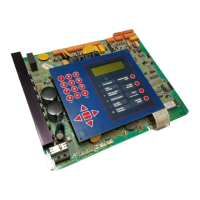104 AFP-200 Instruction PN 15511:F2 10/11/99
Appendix I Terminal Interface Protocol
General Description
The control panel can communicate with a remote terminal or computer connected to its EIA-232 port (TB4), as
described in Section 2.6 of this manual. Refer to the EIA-232D Protocol And Data Formats for the control
panel, Document 50078, for a complete description of the remote terminal or computer. The EIA-232 port can
be configured for interactive operation or for monitoring only. Interactive operation requires that all equipment
be listed under UL Standard for Safety UL864 and be installed/configured as directed under Local Terminal
Mode (LocT) or Local Monitor Mode (LocM). EDP-listed equipment is permitted for ancillary system
monitoring when the system is installed/configured as directed under Remote Monitor Mode (RemM). Use of
EDP-listed equipment is also permitted for system servicing or programming.
The EIA-232 ports on some terminals/computers, including the CRT, are not isolated from earth ground. These
devices should be connected to the control panel via isolation modems, since their direct connection would
introduce a ground fault.
There are three different operating modes for the EIA-232 port; Local Terminal, Local Monitor, and Remote
Monitor. The operating mode is selected during panel programming, under the system parameters section
(7=SYSTEM). The operation of each mode is described below.
Modes of Operation
Local Terminal Mode (LocT)
Local Terminal Mode operation lets you perform Read Status and Alter Status operations from the terminal. In
addition you can also do Acknowledge, Signal Silence, System Reset, and perform a Drill functions from the
CRT. A user-definable password is required to perform the Alter Status function. The functions described
below are available when operating in Local Terminal Mode. The Terminal must be mounted in a UL-864 listed
enclosure, a Notifier Rack-51, Rack-67 or arranged to provide equivalent protection against unauthorized use.
• Read Status
Display the status of an individual point (detector, module, panel circuit, or zone)
Display a list of all the points in alarm or trouble
Display a list of all programmed points in the system
Step through the history buffer event by event
Display the entire history buffer
• Alter Status
Disable/Enable an individual point
Change the sensitivity of a detector
Clear the verification counter of all detectors
Clear the entire history buffer
Set the AWACS Alert and Action levels
• Control Functions
Acknowledge
Signal Silence
System Reset
Drill
Local Monitor Mode (LocM)
Local Monitor mode operation allows the same functions as Local Terminal mode with the exception that a
password is required to perform Acknowledge, Alarm Silence, System Reset, and Drill. Because of this
password security feature, the terminal does not need to be enclosed in a rack to prevent unauthorized use.

